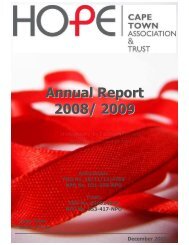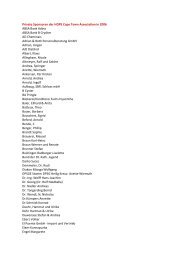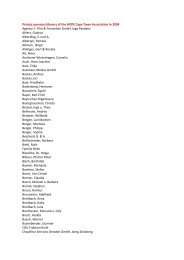You also want an ePaper? Increase the reach of your titles
YUMPU automatically turns print PDFs into web optimized ePapers that Google loves.
first results of this project at the 6th International Conference on Pharmaceutical and<br />
Pharmacological Sciences, Durban, South Africa (25.-27.09.2011), and has also published a review of<br />
the laboratory technologies used in his studies (Curr Drug Metabol 13: 215-224, 2012).<br />
This research project was made possible by the initial support from the HOPE Kapstadt Stiftung via<br />
the German AIDS Foundation.<br />
Sangomasproject<br />
7.3 Nutrition Students – Hochschule Niederrhein<br />
We are now into the third year of student exchange and in February, Vaneska Wendt and Silvia<br />
Falkowska, from Hochschule Niederrhein in Germany, joined HOPE <strong>Cape</strong> <strong>Town</strong> for four weeks.<br />
The students worked in the nutrition project in Blikkiesdorp, educating women about healthy food<br />
and cooking. Vaneska and Silvia encouraged the women to buy healthy products, showed them how<br />
to prepare the food and how to become moneywise.<br />
Vaneska explained that she was surprised to find how many people do not have a basic knowledge<br />
about food. A further surprise was that most people in the townships buy expensive unhealthy food<br />
instead of healthier food which may even be cheaper. The main reason appears to be status. White<br />
bread is seen to be for rich people and brown bread for the poor, since white bread is more<br />
expensive. It is difficult to change this kind of thinking, because of prejudice in the community.<br />
Vaneska and Silvia perceive this mind-set to be the biggest problem. However, the students do hope<br />
that they were able to make a difference. To demonstrate to the women how expensive unhealthy<br />
food is, Vaneska and Silvia demonstrated a practical comparison. With just 40 Rand (4 Euro`s) the<br />
students went into the community to see what products they could buy. The 40 Rand bought a big<br />
bag of vegetables, while with the same amount they could buy only one 2 l bottle of Coca Cola, one<br />
white bread and two bags of crisps. One of the women in the nutrition group then remarked that<br />
she was already implementing some of the advice that Vaneska and Silvia gave her.<br />
The students also lent a helping hand in the soup kitchen in Blikkiesdorp and in the Ithemba ward at<br />
Tygerberg Hospital. They participated in the Community Health Worker training to teach the<br />
Community Health Workers about healthy food and ways to teach this to the community. Vaneska<br />
and Silvia said that they had a great life experience at HOPE.<br />
“HOPE <strong>Cape</strong> <strong>Town</strong> is a great organisation that works at the roots of the HIV/AIDS problem. The<br />
nutrition group is a good example of this.” The students hope that they were able to inspire the<br />
women to start buying healthy products for themselves and their children.<br />
25







